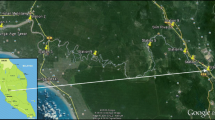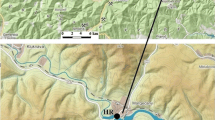Abstract
Purpose
Sorption, desorption, and leaching of metals in the sediments of the aquatic environment are paramount important in their bioavailability. Also, behavior of these metals in such sediments as the riverbed sediments is affected by the characteristics of the sediments such as grain size, pore size distribution, and pH of the medium. Four riverbed sediments with varying properties were artificially contaminated with cadmium (Cd), copper (Cu), nickel (Ni), and zinc (Zn). Then, using leaching columns, they all were subjected to drying and wetting phases to study the competitive binding and release of metals.
Materials and methods
Sediment samples were collected from 0 to 10 cm depth of Abshineh and Ghareh Chai River during the dry season. Samples were spiked with 400 mg Zn kg−1, 200 mg Cu kg−1, 200 mg Ni kg−1, and 50 mg Cd kg−1 (dry weight equivalent) in plastic container and then after drying seated at a height of 10 cm in leaching column. Sediment columns were incubated at room temperature (22–24 °C) and leached with 10–20 pore volumes (PVs) with distilled water. The distribution of metals over different extractable fractions was evaluated before leaching.
Results and discussion
The four metals were separated into two classes according to their leachability. In the sediment columns that contained more clay, commonly mobile metals like Zn, Ni, and Cd that appeared to be rather immobile and commonly immobile metals like Cu were unexpectedly quite mobile. The observation that copper leachability was higher for the sediments with finer grain size and higher organic matter content indicates that pore size distribution, the presence of organically complexes, and colloidal particles, may have had major role in this mobility behavior of copper. The mobility of Zn and Cd are strongly governed by pH, where the mobility of Cd is typically much greater than Zn under acidic conditions. The metal addition caused the displacement of Ca, Mg, K, and Na their subsequent leachate from the spiked sediment columns.
Conclusions
Despite the spiking of inorganic metals into the sediments and drying before leaching, the mobilization of metals with distilled water (to mimic rainwater) was small in the different sediments relative to the total amounts of each metal added. This would indicate that the major part of the added metals were likely to be bound in forms that exhibit a low potential for release to the environment and low bioavailability to organisms.








Similar content being viewed by others
References
Atkinson CA, Jolly DF, Simpson SL (2007) Effect of overlying water pH, dissolved oxygen, salinity and sediment disturbances on metal release and sequestration from metal contaminated marine sediment. Chemosphere 69:1428–1437
Bacon JR, Davidson CM (2008) Is there a future for sequential chemical extraction? Analyst 133:25–46
Baes CF, Mesmer RE (1976) The hydrolysis of cations. Wily, New York
Besser JM, Brumbaugh WG, May TW, Ingersoll CG (2003) Effects of organic amendments on the toxicity and bioavailability of cadmium and Cu in spiked formulated sediments. Environ Toxicol Chem 22:805–815
Besser JM, Brumbaugh WG, Ingersoll CG, Ivey CD, Kunz JL, Kemble NE, Schlekat CE, Garman ER (2013) Chronic toxicity of nickel-spiked freshwater sediments: variation in toxicity among eight invertebrate taxa and eight sediments. Environ Toxicol Chem 32:2495–2506
Burton ED, Phillips IR, Hawker DW (2006) Factors controlling the geochemical partitioning of trace metals in estuarine sediments. Soil Sediment Contam 15:253–276
Calmano W, Hong J, Förstner U (1993) Binding and mobilization of heavy metals in contaminated sediments affected by pH and redox potential. Water Sci Technol 28:223–235
Campana O, Blasco J, Simpson SL (2013) Demonstrating the appropriateness of developing sediment quality guidelines based on sediment geochemical properties. Environ Sci Technol 47:7483–7489
Cappuyns V, Swennen RS (2008) The use of leaching tests to study the potential mobilization of heavy metals from soils and sediments: a comparison. Water Air Soil Pollut 191:95–111
Cappuyns V, Swennen RS, Verhulst J (2004) Assessment of acid neutralizing capacity and potential mobilization of trace metals from land-disposed dredged sediments. Sci Total Environ 333:233–247
Chapman PM, Wang F, Janssen C, Persoone G, Allen HE (1998) Ecotoxicology of metals in aquatic sediments: binding and release, bioavailability, risk assessment, and remediation. Can J Fish Aquat Sci 55:2221–2243
Donat R, Akdogan A, Erdem E, Cetisli H (2005) Thermodynamics of Pb2+ and Ni2+ adsorption onto natural bentonite from aqueous solutions. J Colloid Interface Sci 286:43–52
Echeverria JC, Morera MT, Mazkiarán C, Garrido JJ (1998) Competitive sorption of heavy metal by soils. Isotherms and fractional factorial experiments. Environ Pollut 101:275–284
Förstner U (1995) Non-linear release of metals from aquatic sediments. In: Salomons W, Stigliani WM (eds) Biogeodynamics of pollutants in soils and sediments. Springer Verlag, Berlin, pp 247–307
Ganne P, Cappuyns V, Vervoot A, Buvé L, Swennen R (2006) Leachability of heavy metals and arsenic from slags of metal extraction industry at Angleur (eastern Belgium). Sci Total Environ 356:69–85
Gibbs RJ (1977) Transport phases of transition metals in the Amazon and Yukon Rivers. Geo Soc Am Bullet 88:829–843
Gundersen P, Steinnes E (2003) Influence of pH and TOC concentration on Cu, Zn, Cd and Al speciation in rivers. Water Res 37:307–318
Hagopian-Schlekat T, Chandler GT, Shaw TJ (2001) Acute toxicity of five sediment-associated metals, individually and in a mixture, to the estuarine meiobenthic harpacticoid copepod Amphiascus tenuiremis. Mar Environ Res 51:247–264
He ZL, Zhang M, Yang XE, Stoffella PJ (2006) Release behavior of copper and zinc from sandy soils. Soil Sci Soc Am J 70:1699–1707
Hong YS, Kinney KA, Reible DD (2011) Effect of cyclic changes in pH and salinity on metals release from sediments. Environ Toxicol Chem 30:1775–1784
Horowitz AJ, Elrick KA (1987) The relation of stream sediment surface area, grain size and composition to trace element chemistry. Appl Geochem 2:437–451
Hutchins CM, Teasdale PR, Lee J, Simpson SL (2007) The effect of manipulating sediment pH on pore water chemistry of copper- and zinc-spiked sediments. Chemosphere 69:1089–1099
Hutchins CM, Teasdale PR, Lee SY, Simpson SL (2008) Cu and Zn concentration gradients created by dilution of pH neutral metal-spiked marine sediment: a comparison of sediment geochemistry with direct methods of metal addition. Environ Sci Technol 42:2912–2918
Kabata-Pendias A, Pendias H (2001) Trace element in soils and plants, 2nd edn. CRC Press, Boca Raton, p 413
Kandpal G, Srivastava PC, Ram B (2005) Kinetics of desorption of heavy metals from polluted soils: influence of soil type and metal source. Water Air Soil Pollut 161:353–363
Li Z, Shuman LM (1996) Mobility of Zn, Cd, and Pb in soils as affected by poultry litter extract. II. Redistribution among soil fractions. Environ Pollut 95:227–234
Li QS, Liu YN, Du YF, Cui AH, Shi L, Wang LL, Li HJ (2011) The behavior of heavy metals in tidal flat sediments during fresh water leaching. Chemosphere 82:834–838
Lindsay WL (1979) Chemical equilibria in soils. John Wiley and Sons Inc, New York
Lu A, Zhang S, Shan XQ (2005) Time effect on the fractionation of heavy metals in soils. Geoderma 125:225–234
Mbila MO, Thompson ML, Mbagwu JS, Laird DA (2001) Distribution and movement of sludge-derived trace metals in selected Nigerian soil. J Environ Qual 30:1667–1674
McBride MB (1989) Reactions controlling heavy metal solubility in soils. Adv Soil Sci 10:1–56
McBride MB (1994) Environmental chemistry of soils. Oxford University Press, New York
McKenzie RM (1980) The adsorption of lead and other heavy metals on oxides of manganese and iron. Aust J Soil Res 18:61–73
McLean JE, Bledsoe BE (1994) Groundwater issue: behavior of metals in soils, superfound technology support center for ground water USEPA540/S-92/018. Washington, DC
Römkens PFAM, Dolfing J (1998) Effect of Ca on the solubility and molecular size distribution of DOC and Cu binding in soil solution samples. Environ Sci Technol 32(3):363–369
Rowell DL (1994) Soil science: methods and application. Longman Group, Harlow
Schreiber M, Fedotov SP, Wennrich R (2005) Dynamic studies on the mobility of trace metals in soil and sediment samples influenced by dumping of residues of the Mulde River region in 2002. Chemosphere 61:107–115
Shaheen MS, Tsadilas CD, Rinklebe J (2013) A review of the distribution coefficients of elements in soils: influence of sorption system, element characteristics, and soil colloidal properties. Adv Colloid Interf Sci 201–202:43–56
Sheikhhosseini A, Shirvani M, Shariatmadari H, Zvomuya F, Najafic B (2014) Kinetics and thermodynamics of nickel sorption to calcium-palygorskite and calcium-sepiolite: a batch study. Geoderma 217–218:111–117
Simpson SL, Batley GE (2007) Predicting metal toxicity in sediments: a critique of current approaches. Integr Environ Assess Manag 3:18–31
Simpson SL, Angel BM, Jolley DF (2004a) Metal equilibration in laboratory-contaminated (spiked) sediments used for the development whole-sediment toxicity tests. Chemosphere 54:597–609
Simpson SL, Maher EM, Jolley DJ (2004b) Processes controlling metal transport and retention as metal-contaminated groundwaters efflux through estuarine sediments. Chemosphere 56:821–831
Simpson SL, Fitzpatrick RW, Shand P, Angel BM, Spadaro DA, Mosley L (2010) Climate-driven mobilisation of acid and metals from acid sulfate soils. Marine Freshwater Res 61:129–138
Simpson SL, Vardanegam CR, Jarolimek C, Jolley DF, Angel BA, Mosley LM (2014) Metal speciation and potential bioavailability changes during discharge and neutralisation of acidic drainage water. Chemosphere 103:172–180
Sipos P, Németh T, Kis VK, Mohai I (2008) Sorption of copper, zinc and lead on soil mineral phases. Chemosphere 73:461–469
Sparks DL (2003) Environmental soil chemistry, 2nd edn. Academic Press, San Diego
Sparks DL, Rechcigl JE (1982) Comparison of batch and miscible displacement techniques to describe potassium adsorption kinetics in Delaware soil. Soil Sci Soc Am J 46:875–877
Sparks DL, Zelazny LW, Martens DC (1980) Kinetics of potassium desorption in soil using miscible displacement. Soil Sci Soc Am J 44:1205–1208
Sposito G, Lund LJ, Chang AC (1982) Trace metal chemistry in arid-zone field soils amended with sewage sludge: I. Fractionation of Ni, Cu, Zn, Cd, and Pb in solid phases. Soil Sci Soc Am J 46:260–264
Stevens DP, McLaughlin MJ, Heinrich T (2003) Determining toxicity of lead and zinc runoff in soil: salinity effects on metal partitioning and on phytotoxicity. Environ Toxicol Chem 22:3017–3024
Strom D, Simpson SL, Batley GE, Jolley DF (2011) The influence of sediment particle size and organic carbon on toxicity of copper to benthic invertebrates in oxic/sub-oxic surface sediments. Environ Toxicol Chem 30:1599–1610
Stumm W, Morgan JJ (1996) Aquatic Chemistry. Chemical equilibria and rates in natural waters. John Wiley & Sons, New York
Temminghoff EJM, VanderZee S, deHann FAM (1997) Copper mobility in copper-contaminated sandy soil as affected by pH and solid and dissolved organic matter. Environ Sci Technol 31:1109–1115
Tyler LD, McBride MB (1982) Mobility and extractability of Cd, Cu, Ni, and Zn in organic and mineral soil columns. Soil Sci 143:198–295
Ullrich MS, Ramsey HM, Helios-Rybicka E (1999) Total and exchangeable concentrations of heavy metals in soil near Bytom, an area of Pb/Zn mining and smelting in Upper Silesia, Poland. Appl Geochem 14:187–196
Usman ARA (2008) The relative adsorption selectivities of Pb, Cu, Zn, Cd, and Ni by soils developed on shale in New Valley, Egypt. Geoderma 144:334–343
Wang F, Wang H, Al-Tabbaa A (2014) Leachability and heavy metal speciation of 17-year old stabilized/solidified contaminated site soils. J Hazard Mater 278:144–151
Acknowledgments
The first author is especially grateful to Dr. Stuart L. Simpson, Dr. Adel Shirmohammadi, Dr. Nico M. van Straalen, and two anonymous reviewers for critical review and perceptive comment on the manuscript.
Author information
Authors and Affiliations
Corresponding author
Additional information
Responsible editor: Marcel van der Perk
Rights and permissions
About this article
Cite this article
Arfania, H., Asadzadeh, F. Mobility of heavy metals after spiking in relation to sediment and metal properties: leaching column study. J Soils Sediments 15, 2311–2322 (2015). https://doi.org/10.1007/s11368-015-1166-7
Received:
Accepted:
Published:
Issue Date:
DOI: https://doi.org/10.1007/s11368-015-1166-7




